2001 – What was Steve Jobs thinking? That seems to be the #1 question on the Mac Web and in the online computer press around the world. Blue Dalmatian? Flower Power?
For the most part, comments have been negative: What were they smoking? It looks like someone barfed flowers on the iMac? Doesn’t the world consider the Mac a toy without this?
What Was Apple Thinking?
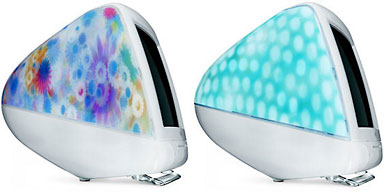 Those are mostly visceral reactions to the biggest change in the look of computers since – well, since Steve Jobs and Jonathan Ive created the iMac, the iBook, the new Power Mac case, and the Cube. The only computer Apple makes that isn’t 100% visually distinctive from its Windows alternatives is the TiBook – and with a mega-wide display and large illuminated Apple logo, it’s not hard to see the TiBook as an Apple, not a Vaio.
Those are mostly visceral reactions to the biggest change in the look of computers since – well, since Steve Jobs and Jonathan Ive created the iMac, the iBook, the new Power Mac case, and the Cube. The only computer Apple makes that isn’t 100% visually distinctive from its Windows alternatives is the TiBook – and with a mega-wide display and large illuminated Apple logo, it’s not hard to see the TiBook as an Apple, not a Vaio.
Computer users derided the iMac for its shape, color, missing floppy, too slow modem, lack of SCSI, and round mouse. Apple threw us a bone: the 33.6 modem became a 56k modem before it shipped – and the iMac went on to become the best selling personal computer for months on end. Today the iMac accounts for over 50% of all Macs sold and outsells the Power Mac by over 50%.
Computer users derided the iBook for its “girlie” colors, handle, overly rounded shape, small hard drive, lack of RAM, and slow processor. Again consumers lined up for the latest Apple. Over the past year, Apple sold 50% more iBooks than PowerBooks.
Apple understands the consumer market. Geeks want MHz, MIPS, polygons per second, 10,000 rpm hard drives, and ludicrous amounts of memory. Consumers want tools that work.
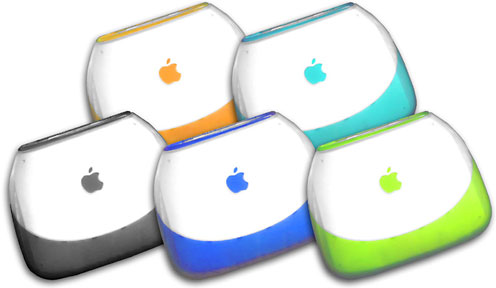
The iBook works. Apple has bumped speed, memory, and drive size. They’ve lowered the price and replaced blueberry with indigo. And it continues to sell – even a few units in key lime. (Really, I saw someone using one at the Expo.)
The iMac works. Apple has increased memory, drive size, and CPU speed. They’ve lowered the price and come up with several different color schemes. And it continues to sell – even a few units in tangerine.
Under Steve Jobs’ leadership, Apple is very consumer savvy. They may have created one model with a niche market (the Cube), but all the other models have been home runs.
Choices
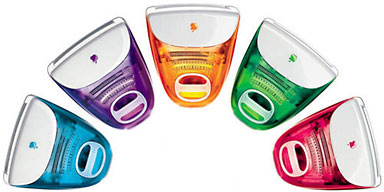 Granted, some colors did better than others. During the “fruity flavors” era, I believe blueberry accounted for close to 50% of all sales. Grape, tangerine, strawberry, and lime all took a back seat – but in nine months on the market (counting both the 266 and 333 MHz versions), Apple probably sold about 150,000 units in each of the less popular colors.
Granted, some colors did better than others. During the “fruity flavors” era, I believe blueberry accounted for close to 50% of all sales. Grape, tangerine, strawberry, and lime all took a back seat – but in nine months on the market (counting both the 266 and 333 MHz versions), Apple probably sold about 150,000 units in each of the less popular colors.
The slot-loading iMacs continued the same color scheme for nine months, at least on the DV. Again, Apple probably sold over 100,000 of each of the less popular colors while selling well over 600,000 blueberry iMacs at 350 and 400 MHz – and the graphite Special Edition on top of that.
This gave Apple seven iMacs, once you factored in three speeds and six colors.
Last July, Apple introduced a new range of colors: indigo, ruby, sage, and snow. Graphite was the only “old color” they retained. The base iMac came in indigo. One step up, buyers had the choice of indigo or ruby. At the next level, Apple gave sage as a third choice. And at the top, the choice was between snow and graphite.
That resulted in eight combinations of speed (350, 400, 450, and 500 MHz) and color.
iMac sales were up 21% in fiscal 2000 compared with fiscal 1999.
A lot of us thought there were too many choices; Apple obviously agrees. The new iMacs come in four color schemes (indigo, flower power, blue Dalmatian, and graphite) and three speeds (400, 500, and 600 MHz). But in the end, the number of choices remains at seven.
Good Choices?
The small differences in clock speed (500 MHz is only 11% faster than 450 MHz) have been replaced by more significant ones (600 MHz is 20% faster than 500 MHz), and the top end uses a more efficient CPU and an improved graphics subsystem.
As with the last two iMac families, those who want the entry level machine have a choice of blue. It was the most popular color when buyers were given a choice, so Apple reasoned that it’s the best default choice on the low end. I have to agree with that – and we avoid the whole issue of flower power and blue Dalmatian vs. indigo for that market.
For those who want CD-R for burning CDs, Rage Ultra video for gaming, or more than 400 MHz of G3 performance, Apple offers 500 and 600 MHz iMacs. (Yes, the international version of the 500 MHz model lacks Rage Ultra – we don’t understand why.) Buyers can choose a conservative 500 MHz indigo iMac, a professional graphite 600 MHz iMac, or something a bit more colorful in either speed.
Odds are the indigo and graphite models will continue to make up the bulk of iMac sales, just as they have in the past. I’ll miss ruby, which I consider the best iMac color ever, and others mourn the passing of sage for the same reason. But Apple is, dare I say it, thinking different.
How Apple Is Thinking
Here’s what I believe Apple is thinking. iMac buyers are iMac buyers. They won’t decline purchase simply because ruby or sage is unavailable. (Note to ruby, sage,and snow fans: buy now – links below) Indigo and graphite will succeed in the home, dorm, and business markets.
But there’s little marginal cost in creating new color schemes for the iMac, especially since they replaced color-matched mice and keyboards with “pro” versions last summer. All the iMacs have the same plastics. On the indigo model, the speaker grilles and back are indigo. On the graphite SE, these parts are graphite.
The flower power and Dalmatian blue model share even more plastics. The speaker grilles are white, so only the large, colorful back of the computer is different. Thus, the cost of special color schemes is minimal.
Again, nobody is going to decline purchasing an iMac because of the new color schemes. For most of the market, indigo and graphite are fine. And Apple knows it.
Flower Power
 When I first saw pictures of the flower power iMac, I thought it might be going after that growing demographic of white-haired ladies. Retirees. Grandmas. Snowbirds. People who may have retired to the sun belt or a retirement village. People who may not be computer savvy (yet). People who would love to stay in touch with family and friends via email. Were either of my grandmothers still with us, I think they would have found the flower power iMac the only one that would fit their decor. (I’ve heard flower power looks less garish in real life than it does on the Web.)
When I first saw pictures of the flower power iMac, I thought it might be going after that growing demographic of white-haired ladies. Retirees. Grandmas. Snowbirds. People who may have retired to the sun belt or a retirement village. People who may not be computer savvy (yet). People who would love to stay in touch with family and friends via email. Were either of my grandmothers still with us, I think they would have found the flower power iMac the only one that would fit their decor. (I’ve heard flower power looks less garish in real life than it does on the Web.)
Others think of teenage girls as the most likely market, a group that tends to be left behind by the techie side of the computer revolution. I think that’s an astute guess as well.
And there’s a whole world of homes decorated with floral wallpaper, so it’s evident that a lot of people think floral patterns are an appropriate way to decorate. Bingo – the first computer with a floral pattern!
Blue Dalmatian
I must admit to being stumped by blue Dalmatian – white spots on a blue background? Maybe Apple thinks it will appeal to the college and career crowd. I just don’t know. It’s less gaudy than flower power, but I think it’s also less marketable.
Time will tell. Best of all, if the whole thing blows up in Apple’s face, all they have to do is replace one piece of plastic to change the color scheme.
Not that I expect that to happen. Apple is pretty consumer savvy. Shoot, even the Cube, which many consider a dismal failure, sold over 100,000 units during its first quarter-year on the market.
Image Is Everything
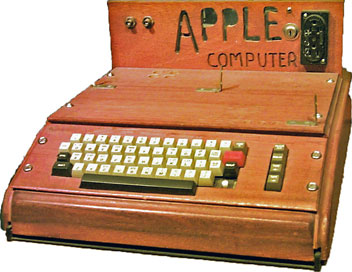 The personal computer has been around for a quarter century, and Apple has been there the whole time. The first computers were for hobbyists – the Apple I had no case, keyboard, or power supply.
The personal computer has been around for a quarter century, and Apple has been there the whole time. The first computers were for hobbyists – the Apple I had no case, keyboard, or power supply.
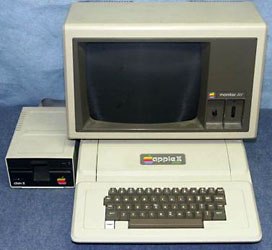 With the Apple II, Apple changed all that. It had a keyboard and a beige case. You could hook it up to your cassette tape recorder. It could drive a composite color monitor – or display color on your television with an adapter. Apple turned the hobbyist’s bareboard Apple I into a consumer computer with the Apple II. It became the best known brand on the market.
With the Apple II, Apple changed all that. It had a keyboard and a beige case. You could hook it up to your cassette tape recorder. It could drive a composite color monitor – or display color on your television with an adapter. Apple turned the hobbyist’s bareboard Apple I into a consumer computer with the Apple II. It became the best known brand on the market.
Other companies went after the business market with CP/M machines. No graphics. No color. Bulky 8″ floppy drives. No nonsense metal cases. But Apple and others went after the home market.
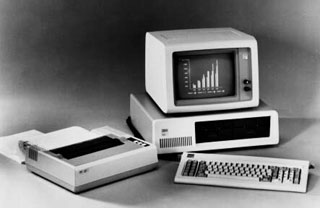 IBM targeted the business market with the introduction of the Personal Computer in 1981. IBM didn’t bet the farm; it chose to use as many off the shelf components as possible and didn’t even create its own operating system. The PCs had little personality, offered little that the CP/M boxes didn’t have, but had those all-important initials IBM.
IBM targeted the business market with the introduction of the Personal Computer in 1981. IBM didn’t bet the farm; it chose to use as many off the shelf components as possible and didn’t even create its own operating system. The PCs had little personality, offered little that the CP/M boxes didn’t have, but had those all-important initials IBM.
An entire industry sprang up boxing the same components as IBM and bundling them with the operating system from Microsoft. Within a few years, anyone could build a clone from stock parts for personal use or to sell. Computers became commodities.
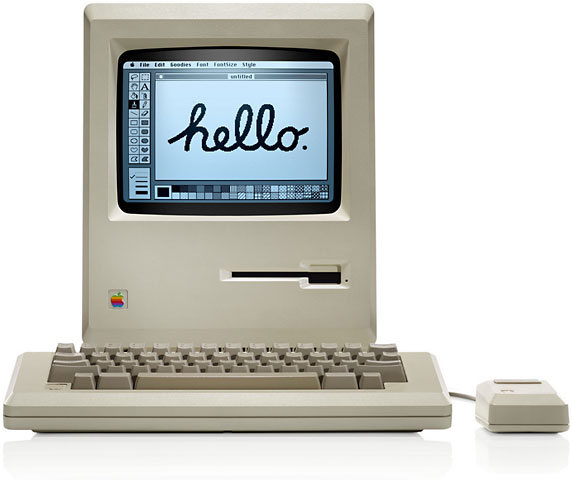 Not so with Apple. Their response to the depersonalization of the personal computer market (ironic, isn’t it), was the Macintosh. It was cute and friendly, compact and easy to set up. You used a mouse, so you didn’t have to learn cryptic commands or be a good typist. Computing was fun again.
Not so with Apple. Their response to the depersonalization of the personal computer market (ironic, isn’t it), was the Macintosh. It was cute and friendly, compact and easy to set up. You used a mouse, so you didn’t have to learn cryptic commands or be a good typist. Computing was fun again.
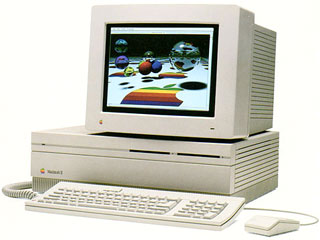 Apple went corporate in 1985, the year Steve Wozniak and Steve Jobs left Apple. The Mac II, introduced in March 1987, was “the new Apple’s” response to the PC industry. It ran the Mac OS, but it looked like a business machine. The Mac II was a fine computer, but it traded some personality for acceptability.
Apple went corporate in 1985, the year Steve Wozniak and Steve Jobs left Apple. The Mac II, introduced in March 1987, was “the new Apple’s” response to the PC industry. It ran the Mac OS, but it looked like a business machine. The Mac II was a fine computer, but it traded some personality for acceptability.
From that point on, Apple has been divided between the home and business user. The compact Macs, the LCs and 500 series, and the Performas were consumer computers. The modular Macs were for business, especially graphic artists. But with each step away from the compact all-in-one design, the new Macs traded personality for acceptance.
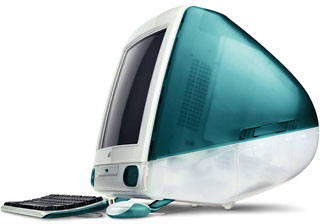 With the iMac, computing became fun again for the average consumer. (It’s always been fun for geeks and gamers, but there are a lot more average consumers than geeks and gamers.) Each new model since the return of Steve Jobs has been different: the colorful and compact iMac, the curvy iBook, the clever Power Mac tower with handles, and the stunningly wide PowerBook G4.
With the iMac, computing became fun again for the average consumer. (It’s always been fun for geeks and gamers, but there are a lot more average consumers than geeks and gamers.) Each new model since the return of Steve Jobs has been different: the colorful and compact iMac, the curvy iBook, the clever Power Mac tower with handles, and the stunningly wide PowerBook G4.
Flower power and blue Dalmatian fit into that concept of computing, that paradigm of personal empowerment. Like the Apple II and early Macs, the iMac is an appliance to be used, a tool for the mind. If geeks and gamers want ’em, fine, but iMacs are meant for Mom and Dad, Grandma and Grandpa, your little sister, and students at any level of their education.
I think that’s what Steve Jobs was thinking.
Links: Ruby, Sage, and Snow iMacs
The following vendors have ruby, sage, and/or snow iMacs in stock. As these are discontinued items, supplies are limited. Prices and availability is subject to change.
| Ruby DV | Ruby DV+ | Sage DV+ | Snow SE | |
| Club Mac | $999 | $1,294 | $1,294 | $1,494 |
| MacConnection | $899 | sold out | sold out | sold out |
| MacMall | $999 | $1,294 | $1,294 | sold out |
| Mac Zone | $900 | $1,295 | $1,295 | $1,495 |
| Outpost.com | $895 | sold out | sold out | sold out |
| Small Dog Electronics | $899 | sold out | sold out | $1,199 |
Keywords: #flowerpowerimac #flowerpower #bluedalmatian #bluedalmation
Short link: http://goo.gl/BlUt8n
searchword: flowerpower

